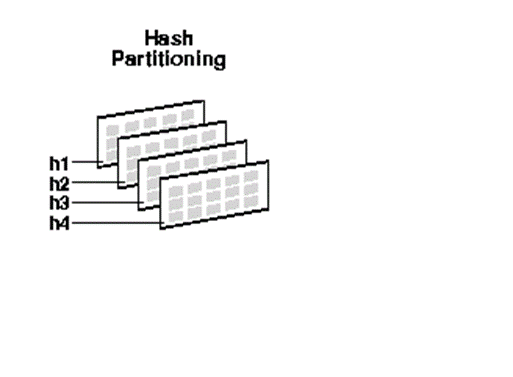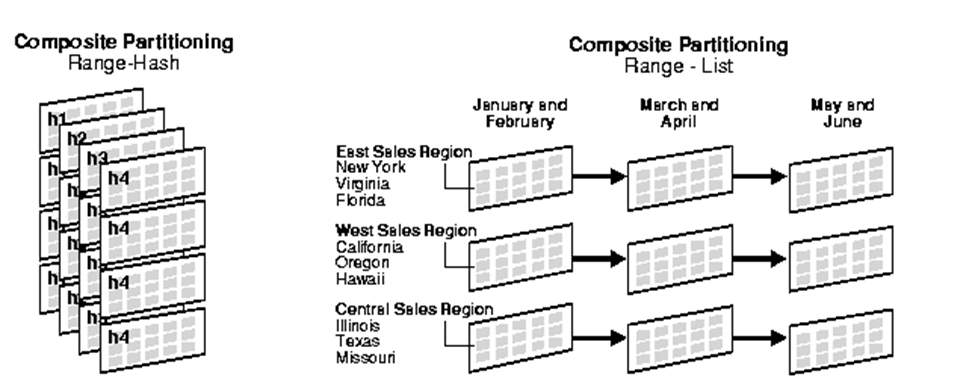Oracle Table Partition
Table partitioning in Oracle is a database feature that allows you to divide a large table into smaller, more manageable segments called partitions. Each partition is an independent unit that stores a subset of the data in the table. Partitioning is designed to improve performance, simplify data management, and enhance maintenance tasks, especially for large datasets. Oracle supports several methods of table partitioning, and you can choose the most suitable one based on your data and query patterns. The main partitioning methods are range, list, hash, and interval. Here's an overview of each:
Range Partition
In range partitioning, rows are distributed across partitions based on
a specified range of values for a chosen partitioning column. For example, you
can partition a sales table by date, grouping sales data into partitions based
on date ranges.
CREATE TABLE sales (
sale_id NUMBER,
sale_date DATE,
amount NUMBER
)
PARTITION BY RANGE (sale_date) (
PARTITION sales_q1 VALUES LESS
THAN (TO_DATE('01-APR-2022', 'DD-MM-YYYY')),
PARTITION sales_q2 VALUES LESS
THAN (TO_DATE('01-JUL-2022', 'DD-MM-YYYY')),
PARTITION sales_q3 VALUES LESS
THAN (TO_DATE('01-OCT-2022', 'DD-MM-YYYY')),
PARTITION sales_q4 VALUES LESS
THAN (MAXVALUE)
);
List Partition
In list partitioning, rows are distributed based on a
discrete list of values for a chosen partitioning column. This allows you to
group data into partitions based on specific values in a column.
CREATE TABLE employees (
employee_id NUMBER,
department_id NUMBER,
employee_name VARCHAR2(50)
)
PARTITION BY LIST (department_id) (
PARTITION dept_10 VALUES (10),
PARTITION dept_20 VALUES (20),
PARTITION other_depts VALUES
(DEFAULT)
);
These are examples of how you can group data into partitions based on
specific criteria. If you have a specific context or use case in mind when referring
to "group partitions," please provide more details for a more
accurate response.
Hash Partition
In Oracle, hash partitioning is a method of table
partitioning where rows are distributed across partitions based on the result
of applying a hash function to the values of one or more specified partitioning
columns. Hash partitioning aims to evenly distribute rows across partitions,
making it useful for load balancing and avoiding hotspots in partitioned
tables.
Here's a basic example of how to create a table with hash partitions:
sql
CREATE TABLE employees (
employee_id NUMBER,
employee_name VARCHAR2(50),
department_id NUMBER
)
PARTITION BY HASH (department_id)
PARTITIONS 4;
In this example:
The employees table is hash partitioned based on the department_id
column.
The PARTITIONS 4 clause specifies that the table should have four
partitions.
When a row is inserted into the employees table, the hash function is applied to the value of the department_id, and the result determines the partition where the row will be stored. The goal is to distribute the rows evenly across the specified number of partitions.
Hash partitioning is often used when there is no specific range or list of values that naturally lends itself to partitioning, and an even distribution of data is desired. It can be useful in scenarios where the distribution of data is not known in advance or when the partitioning key doesn't have an inherent order.
Here are some additional considerations:
Changing the Number of Partitions:
You can change the number of hash partitions using the ALTER TABLE ...
MODIFY PARTITIONS statement. However, this operation may require rebuilding the
entire table.
ALTER TABLE employees MODIFY PARTITIONS 8;
Adding Data:
When adding data to a hash-partitioned table, Oracle automatically
determines the partition in which each row should be placed based on the hash
function.
Potential for Data Skew:
While hash partitioning aims to distribute data evenly, there is still
a possibility of data skew, especially if the partitioning column has a skewed
distribution of values.
Hash partitioning is one of several partitioning methods available in
Oracle, and the choice of partitioning method depends on the specific
characteristics of the data and the desired query and maintenance performance.
Composite Partition
In database partitioning, the term "composite partitioning" is often used to refer to a scenario where a table is partitioned using a combination of multiple partitioning methods. This involves applying different partitioning methods to different levels of the partition hierarchy, creating a more sophisticated partitioning strategy.
For example, you might have a table with a range partitioning scheme based on one column at the higher level, and within each range partition, you might further subpartition the data using a hash or list partitioning scheme based on another column.
Here's a conceptual example:
CREATE TABLE example_table (
id NUMBER,
date_column DATE,
category VARCHAR2(20),
value NUMBER
)
PARTITION BY RANGE (date_column)
SUBPARTITION BY HASH (category)
SUBPARTITIONS 4
(
PARTITION p_january VALUES
LESS THAN (TO_DATE('01-FEB-2023', 'DD-MON-YYYY')),
PARTITION p_february VALUES
LESS THAN (TO_DATE('01-MAR-2023', 'DD-MON-YYYY')),
PARTITION p_march VALUES LESS
THAN (TO_DATE('01-APR-2023', 'DD-MON-YYYY')),
PARTITION p_april VALUES LESS
THAN (MAXVALUE)
);
The table is range partitioned by the date_column.
Within each range partition, the data is further
subpartitioned by the category column using hash partitioning.
This combination of range and hash partitioning is
an example of composite partitioning.




No comments:
Post a Comment
If you have any doubt or question, please contact us.